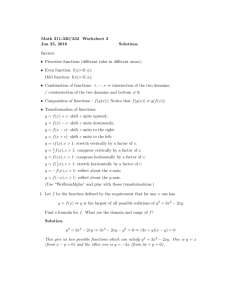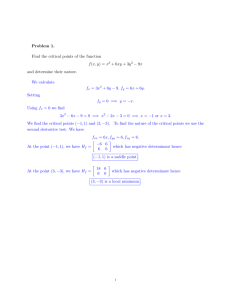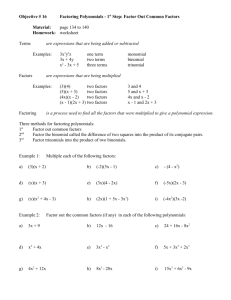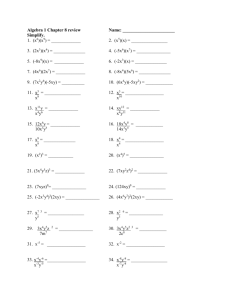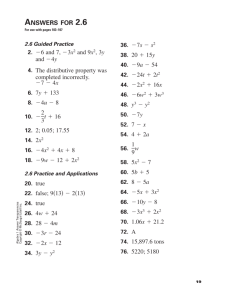x2 −y2 = (x−y)
advertisement
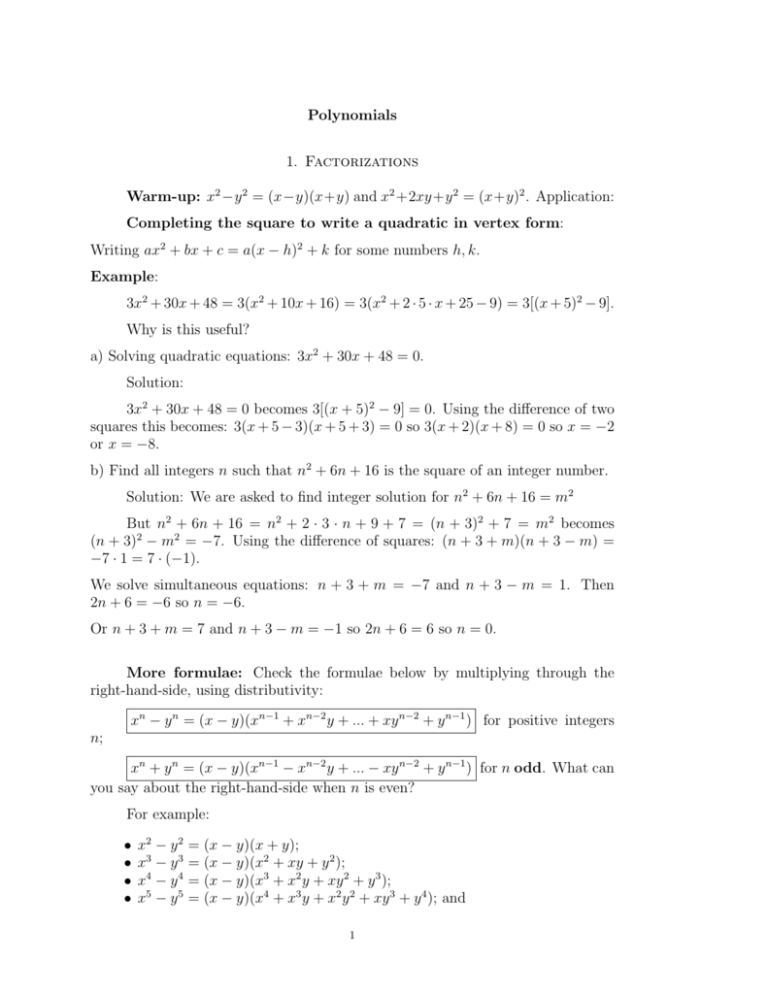
Polynomials 1. Factorizations Warm-up: x2 −y 2 = (x−y)(x+y) and x2 +2xy+y 2 = (x+y)2 . Application: Completing the square to write a quadratic in vertex form: Writing ax2 + bx + c = a(x − h)2 + k for some numbers h, k. Example: 3x2 + 30x + 48 = 3(x2 + 10x + 16) = 3(x2 + 2 · 5 · x + 25 − 9) = 3[(x + 5)2 − 9]. Why is this useful? a) Solving quadratic equations: 3x2 + 30x + 48 = 0. Solution: 3x2 + 30x + 48 = 0 becomes 3[(x + 5)2 − 9] = 0. Using the difference of two squares this becomes: 3(x + 5 − 3)(x + 5 + 3) = 0 so 3(x + 2)(x + 8) = 0 so x = −2 or x = −8. b) Find all integers n such that n2 + 6n + 16 is the square of an integer number. Solution: We are asked to find integer solution for n2 + 6n + 16 = m2 But n2 + 6n + 16 = n2 + 2 · 3 · n + 9 + 7 = (n + 3)2 + 7 = m2 becomes (n + 3)2 − m2 = −7. Using the difference of squares: (n + 3 + m)(n + 3 − m) = −7 · 1 = 7 · (−1). We solve simultaneous equations: n + 3 + m = −7 and n + 3 − m = 1. Then 2n + 6 = −6 so n = −6. Or n + 3 + m = 7 and n + 3 − m = −1 so 2n + 6 = 6 so n = 0. More formulae: Check the formulae below by multiplying through the right-hand-side, using distributivity: xn − y n = (x − y)(xn−1 + xn−2 y + ... + xy n−2 + y n−1 ) for positive integers n; xn + y n = (x − y)(xn−1 − xn−2 y + ... − xy n−2 + y n−1 ) for n odd. What can you say about the right-hand-side when n is even? For example: • • • • x2 − y 2 x3 − y 3 x4 − y 4 x5 − y 5 = (x − y)(x + y); = (x − y)(x2 + xy + y 2 ); = (x − y)(x3 + x2 y + xy 2 + y 3 ); = (x − y)(x4 + x3 y + x2 y 2 + xy 3 + y 4 ); and 1 2 • x3 + y 3 = (x + y)(x2 − xy + y 2 ); • x5 + y 5 = (x + y)(x4 − x3 y + x2 y 2 − xy 3 + y 4 ). n n xn + C1n xn−1 y + C2n xn−2 y 2 + ... + Cn−2 x2 y n−2 + Cn−1 xy n−1 + y n = (x + y)n . For example: • • • • • • • • x2 + 2xy + y 2 = (x + y)2 ; x3 + 3x2 y + 3xy 2 + y 3 = (x + y)3 ; x4 + 4x3 y + 6x2 y 2 + 4xy 3 + y 4 = (x + y)4 ; x5 + 5x4 y + 10x3 y 2 + 10x2 y 3 + 5xy 4 + y 5 = (x + y)5 ; x2 − 2xy + y 2 = (x − y)2 ; x3 − 3x2 y + 3xy 2 − y 3 = (x − y)3 ; x4 − 4x3 y + 6x2 y 2 − 4xy 3 + y 4 = (x − y)4 ; x5 − 5x4 y + 10x3 y 2 − 10x2 y 3 + 5xy 4 − y 5 = (x − y)5 ; Example: Factoring polynomials by combining factorization formulae: • x4 − y 4 = (x2 − y 2 )(x2 + y 2 ) = (x − y)(x + y)(x2 + y 2 ); • x4 + y 4 + x2 y 2 = x4 + y 4 + 2x2 y 2 − x2 y 2 = (x2 + y 2 )2 − x2 y 2 = (x2 + y 2 − xy)(x2 + y 2 + xy); 4 • √ x4 + y 4 = x4 + y√ + 2x2 y 2 − 2x2 y 2 = (x2 + y 2 )2 − 2x2 y 2 = (x2 + y 2 − 2xy)(x2 + y 2 + 2xy); 6 • x − y 6 = (x3 − y 3 )(x3 + y 3 ) = (x − y)(x2 + xy + y 2 )(x + y)(x2 − xy + y 2 ). • x7 + x2 + 1 = (x7 − x) + x + x2 + 1 = x(x6 − 1) + x2 + x + 1 = x(x3 − 1)(x3 + 1) + x2 + x + 1 = x(x − 1)(x2 + x + 1)(x3 + 1) + x2 + x + 1 = (x2 + x + 1)[x(x − 1)(x3 + 1) + 1] Other factorization formulae: x3 + y 3 + z 3 − 3xyz = (x + y + z)(x2 + y 2 + z 2 − xy − xz − yz) . (x + y + z)2 = x2 + y 2 + z 2 + 2xy + 2xz + 2yz. (x21 + y12 )(x22 + y22 ) = (x1 x2 + y1 y2 )2 + (x1 y2 − y1 x2 )2 . 2. Polynomials in one variable x. Division with remainder. Let a(x) and b(x) be two polynomials. Then there exists a unique pair of polynomials q(x) (the quotient) and r(x) (the remainder ) for which a(x) = b(x)q(x) + r(x) and degree r(x) < degree q(x). This is similar to the division algorithm for integers. The greatest common divisor d(x) of two polynomials a(x) and b(x) is a polynomial of largest degree which divides exactly into both a(x) and b(x). It can be found by repeated division (Euclid’s algorithm). 3 Example: Find the greatest common divisor of x3 +x2 −3x−6 and x3 −3x−2. By division we get x3 + x2 − 3x − 6 = (x3 − 3x − 2) + (x2 − 4) x3 − 3x − 2 = (x2 − 4) x + (x − 2) x2 − 4 = (x − 2) (x + 2) + 0 so x−2 divides x2 −4 and hence also x3 −3x−2 and hence also x3 +x2 −3x−6. The greatest common divisor is x − 2. The Remainder Theorem: Let a be a constant. Dividing a polynomial P (x) by (x − a) yields the number P (a) as remainder: P (x) = (x − a)Q(x) + P (a). Proof: Indeed, since (x − a) has degree 1, the remainder must have degree 0 and hence be a number, let’s call it R. P (x) = (x − a)Q(x) + R. Set x = a to get p(a) = r. So (x − a) is a factor of P (x) if and only if P (a) = 0. Example: Factor P (x) = x3 − 5x2 + 3x + 1. Solution: We search for an integer number a such that P (a) = 0. Then a − 5a2 + 3a + 1 = 0 so a3 − 5a2 + 3a = −1. Since the left-hand-side is a multiple of a, then a must be a divisor of −1. 3 We try a = 1. Then P (1) = 1 − 5 + 3 + 1 = 0. The remainder theorem implies that P (x) has x − 1 as factor. We can divide P (x) by x − 1 as follows: We note that for any number k we have xk (x−1) = xk+1 −xk and −xk (x−1) = −xk+1 + xk . So we can try to write P (x) as a sum of terms of these forms: P (x) = x3 −x2 −4x2 +4x−x+1 = x2 (x−1)−4x(x−1)−(x−1) = (x−1)(x2 −4x−1). By completing the square: √ 2 2 2 P (x) = (x − 1)(x√2 − 4x + 4 − 5) = (x − 1)[(x − 2) − 5] = (x − 1)[(x − 2) − 5 ]= √ (x − 1)(x − 2 − 5)(x − 2 − 5).

